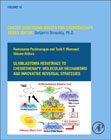
Glioblastoma Resistance to Chemotherapy: Molecular Mechanisms and Innovative Reversal Strategies
Massoud, Tarik F.
Paulmurugan, Ramasamy
Glioblastoma Resistance to Chemotherapy: Molecular Mechanisms and Innovative Reversal Strategies brings current knowledge from an international team of experts on the science and clinical management of glioblastoma chemoresistance. The book discusses topics such as molecular mechanisms of chemoresistance, experimental models to study chemoresistance, chemoresistance to drugs other than Temozolomide, and specific strategies to reverse chemoresistance. Additionally, it encompasses information on how to mitigate chemoresistance by targeted enhancement of p53 function. This book is a valuable resource for cancer researchers, oncologists, neuro-oncologists and other members of the biomedical field. Glioblastoma (GBM) is the most invasive and malignant primary brain tumor in humans with poor survival after diagnosis, therefore it is imperative that molecular and cellular mechanisms behind therapy resistant GBM cells, as well as the therapeutic strategies available to counter the resistance are comprehensively understood. Provides comprehensive, core knowledge related to the entire discipline of glioblastoma chemoresistance, from its many etiological mechanisms, to specific strategies to reverse resistancePresents current information from an international team of experts on the basic science, pre-clinical research, and clinical management of glioblastoma chemoresistanceDiscusses molecular and cellular mechanisms behind therapy resistant glioblastoma cells, as well as the therapeutic strategies available to counter this resistance INDICE: 1. Glioblastoma: Overview of biological hallmarks and molecular pathology 2. Contemporary drug treatment of glioblastoma 3. Investigational new drugs against glioblastoma 4. The hallmarks of anti-cancer drug resistance: An overview 5. Molecular mechanisms of innate and acquired temozolomide resistance in glioblastoma 6. Glioma stem cells and associated molecular mechanisms in glioblastoma chemoresistance 7. Molecular and cellular mechanisms in recurrent glioblastoma chemoresistance 8. Intratumoral heterogeneity associated with glioblastoma drug response and resistance 9. The molecular and cellular effects of radiotherapy-induced microenvironment changes on potential chemoresistance in glioblastoma 10. Role of apoptosis, autophagy and the unfolded protein response in glioblastoma chemoresistance 11. Drug penetration through the BBB after radiotherapy: new approaches to bypass glioblastoma chemoresistance 12. Role of multi-drug resistance (ABC and solute carrier transporters) in glioblastoma chemoresistance 13. Glioblastoma cell-induced immunosuppression causing chemoresistance 14. Impediments to drug delivery in glioblastoma treatment: Nove delivery strategies past the BBB 15. 3D in vitro models to study potentiation of gliobastoma resistance by hypoxia 16. On-chip analysis of glioblastoma chemoresistance 17. Chemoresistance mechanisms in mouse models of glioblastoma 18. Mechanism of glioblastoma chemoresistance to bevacizumab 19. Treatment and resistance of glioblastoma to CAR-T cell immunotherapies 20. Therapeutic approaches to overcome temozolomide resistant glioblastoma 21. Metabolic strategies to overcome glioblastoma chemoresistance 22. Understanding signal transduction pathways to overcome targeted therapy resistance in glioblastoma 23. Therapies to target the molecular mechanisms of glioma stem cell resistance to chemotherapy 24. Vaccines to limit resistance against glioblastoma therapy 25. Role of BMP and TGF-ß signaling in glioblastoma drug resistance and strategies for therapeutic intervention 26. Role of cell quiescence in glioblastoma drug resistance and strategies for therapeutic intervention 27. Role of IncRNAs in temozolomide-resistant glioblastoma 28. Role of mitochondiral reactive oxygen species release in glioblastoma drug resistance and strategies of therapeutic intervention 29. Role of miRNA therapy in pre-sensitizing glioblastoma cells to temozolomide treatment 30. Small molecules targeting p53 stabilization as a therapeutic strategy 31. Small molecules targeting misfolded mutants of p53 as a rescue strategy to improve chemotherapy 32. p53 supplementation as a targeted cancer gene therapy for glioblastoma
- ISBN: 978-0-12-821567-8
- Editorial: Academic Press
- Encuadernacion: Cartoné
- Páginas: 350
- Fecha Publicación: 01/03/2021
- Nº Volúmenes: 1
- Idioma: Inglés
